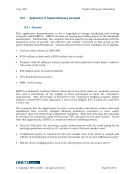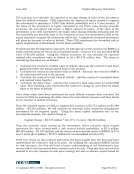June 2007 Capital Adequacy Extension © Copyright 2007, CCRO. All rights reserved. Page 5 of 92 assessed and measured from a silo perspective. Sometimes called “risk buckets” these silos include market, credit, operative, and business risks2. 1.4.1. Economic Capital and Its Components 3 Economic capital is the capital a company needs to hold to financially withstand the risk of an unexpected loss of a predefined magnitude in the value of its portfolio, and still be able to provide collateral and continue operations. Economic capital should encompass all risk classes (market, credit, operative, and business) the enterprise faces. Economic capital is determined at a desired confidence level in the probability distribution of value for a given business. In this paper, we assume that economic capital can be approximated by the unexpected loss in value at some given confidence level. Economic capital may be estimated using a range of methods with varying levels of robustness. It follows that the greater the robustness of the method, the greater will be the transparency, relevance, and applicability of the economic capital measure. For this reason, many energy companies are investing significant resources in developing robust simulation based approaches to assess the distribution of future outcomes for company earnings and cash flow. 1.4.2. Operative Risk Since valid and meaningful quantitative data for operative risk is often lacking, we take an in-depth “guiding principles approach” to managing operative risk. The extensive coverage of guiding principles for managing operative risk is founded on the assumption that effective management of operative risk is process and controls based. We have taken a look at the Basel Committees “10 Principles for Effective Operational Management” and applied them to operative risk management for energy companies. The CCRO notes that operative risk in energy is inherently different from banking due to the presence of physical assets in an energy company’s portfolio. As a result the CCRO adds an “operations” component to the Operative Risk bucket. Operative risk is an integral component of measuring capital adequacy. We define “operative risk” as the sum of “operations risk” and “operational risk”. Operations risk is the risk associated with delivering, producing, or storing physical energy products including unplanned forced outage rates. Operational risk is the risk of direct or indirect loss resulting from inadequate or failed internal processes, people, and systems or from external events. In recent years, there has been much attention devoted to the area of Operative Risk. The previous CCRO paper on Capital Adequacy generally described what an operative risk framework should entail. This paper 2 For more information on the different measures of economic capital, we recommend that the reader refer to the previous CCRO paper “Emerging Practices for Measuring Capital Adequacy”. 3 Taken from CCRO white paper “Emerging Practices for Measuring Capital Adequacy”, Sep 2003, pp4-5
Purchased by unknown, nofirst nolast From: CCRO Library (library.ccro.org)




























































































